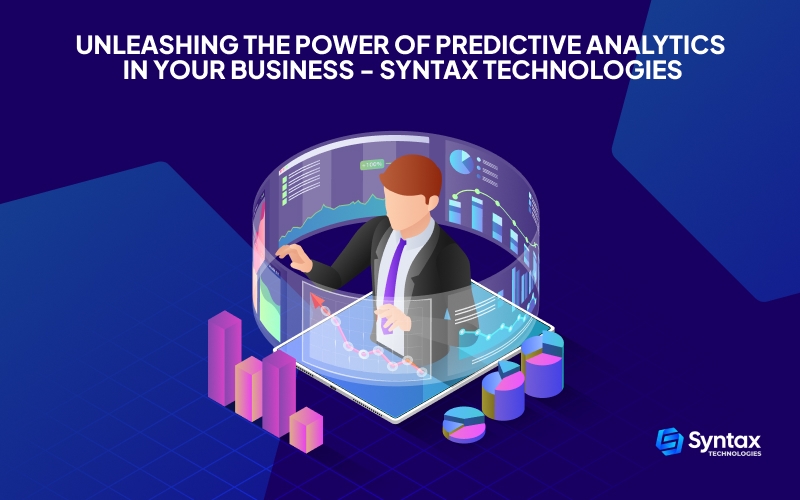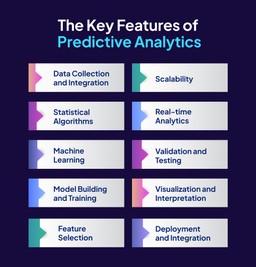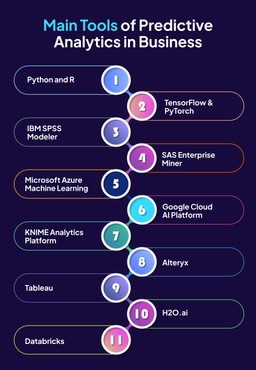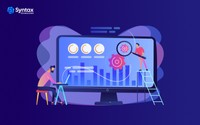Welcome back, data enthusiasts!
Imagine a world where you make sense of past and present trends and get a sneak peek into the future.
That’s the vibrant realm of predictive analytics ? your ticket to decoding the mysteries hidden within the vast sea of business data.
Whether you’re just dipping your toes into the exciting world of data analytics or you’ve been casually wading through it, get ready for a journey that promises to make your data dreams come true.
Think of predictive analytics as your data BFF, your trusty sidekick that helps you understand what’s happening now and gives you a heads-up on what’s around the corner.
In this friendly and welcoming space, we will break down the nitty-gritty of predictive analytics, ditch the jargon, and hand you the keys to unlock its game-changing potential.
And if you’re thinking about getting knees deep in data, look no further than taking a data analytics course to help you face the vast sea of opportunities!
Get ready to unleash the power of predictive analytics and sprinkle some future-telling magic on your business adventures!
What is Predictive Analytics?
Instead of just telling you what’s happening now, predictive analytics uses historical data to make educated guesses about what might happen next.
Imagine you’re running a coffee shop, and predictive analytics tells you that when the weather gets chilly, people are more likely to crave a cozy cup of pumpkin spice latte.
Armed with this insight, you can stock up on pumpkin spice goodness and be the hero of fall!
Predictive analytics is your business fortune-teller, using data to guide you in making more intelligent decisions, spotting trends before they become trends, and giving you a heads-up on what’s coming around the corner.
It’s like having a secret weapon that turns your data into actionable insights and helps you stay one step ahead in the ever-evolving business game.
What are the Key Features of Predictive Analytics?
Predictive analytics has powerful features that transform raw data into invaluable insights.
Here are some key features that make predictive analytics a game-changer:
Data Collection and Integration:
- Predictive analytics starts with gathering data from various sources. This includes historical data, real-time information, and often external datasets. The integration of diverse data sets provides a comprehensive foundation for analysis.
Statistical Algorithms:
- Sophisticated statistical algorithms are the backbone of predictive analytics. These algorithms crunch through the data, identifying patterns, correlations, and trends that might not be apparent through simple observation. Common algorithms include linear regression, decision trees, and neural networks.
Machine Learning:
- Predictive analytics often involves machine learning techniques. Machine learning algorithms enable systems to learn from data patterns and improve their predictions over time. This adaptive learning is crucial for staying relevant in dynamic business environments.
Model Building and Training:
- Predictive models are created based on historical data. These models are then trained to understand the relationships within the data. The training phase fine-tunes the model, ensuring it can make accurate predictions when exposed to new, unseen data.
Feature Selection:
- Not all data features are equally important. Predictive analytics includes identifying and selecting relevant features (variables) that significantly impact future outcomes. This step helps streamline the model, making it more efficient and focused.
Scalability:
- Predictive analytics solutions are designed to handle vast amounts of data. Whether you’re dealing with a small dataset or big data, the scalability of predictive analytics ensures that the system can adapt and provide insights regardless of the data volume.
Real-time Analytics:
- In some applications, real-time predictions are crucial. Predictive analytics systems can be configured to provide instant insights, allowing businesses to respond promptly to changing conditions and make decisions on the fly.
Validation and Testing:
- Thorough validation and testing are essential before deploying predictive models in a live environment. This ensures the accuracy and reliability of predictions, preventing potential errors that could have significant consequences in a business setting.
Visualization and Interpretation:
- Predictive analytics tools often come with visualization features that make it easier for users to interpret complex results. Graphs, charts, and dashboards help communicate insights in a visually accessible manner.
Deployment and Integration:
- Once a predictive model is ready, it needs to be integrated into the business workflow. Leveraging Predictive analytics solutions can facilitate seamless deployment, ensuring that the insights generated can be effectively used to inform decision-making processes.
In combination, these features empower businesses to understand historical data, anticipate future trends, and make informed, strategic decisions.
How Do These Features Translate in Real Life?
Let’s bring these features to life with a real-world scenario. Imagine you’re the owner of an e-commerce business and want to boost your sales during the upcoming holiday season.
Data Mastery and Fusion:
You start by collecting data from your past sales, analyzing customer behavior, website traffic, and external factors like economic trends and social media activity. This integrated dataset forms the basis of your predictive analytics efforts.
Algorithmic Insights:
Your predictive analytics system employs algorithms to analyze historical data. It identifies patterns such as which products are popular during specific holidays when customers make purchases and how pricing strategies impact sales.
Adaptive Learning with Machine Intelligence:
Machine learning algorithms adapt and learn from this data. For instance, they recognize that certain products might have increased demand during particular holidays or that discounts are more effective at specific times.
Crafting and Refining Models:
Using historical data, the system builds a predictive model. It’s trained to understand the relationships between different variables, allowing it to make accurate predictions about future sales based on various inputs.
Strategic Feature Selection:
The system identifies crucial features such as product categories, customer demographics, and promotional activities that significantly influence sales. This helps focus your marketing efforts on what matters most.
Scalability for any Challenge:
As the holiday season approaches, your e-commerce platform experiences a surge in traffic. The scalability of predictive analytics ensures that the system can handle this increased load without sacrificing the accuracy of predictions.
Real-time Precision:
During the holiday season, real-time analytics become crucial. Your predictive analytics system continuously monitors website traffic, sales, and customer behavior, providing instant insights. For example, it might recommend adjusting inventory levels for a trending product.
Validation and Testing:
Before launching holiday promotions, you validate your predictive model to ensure it accurately predicts customer behavior during this specific period. Testing scenarios help you build confidence in the model’s reliability.
Rigorous Visualization and Interpretation:
The system generates visual reports and dashboards that highlight key insights. Clear graphs show which products are likely best-sellers, helping you quickly grasp the information and make informed decisions.
Seamless Deployment and Integration:
Armed with the insights from predictive analytics, you integrate recommended strategies into your holiday marketing campaign. This might include personalized promotions for high-potential customers, optimized pricing, and targeted advertising.
In the end, the features of predictive analytics translate into actionable strategies.
By leveraging data, you can enhance your holiday sales and adapt and refine your approach for future seasons based on continuous learning from the data.
Predictive analytics becomes a valuable ally in navigating the complexities of the e-commerce landscape.
What are the Main Tools of Predictive Analytics in Business?
Predictive analytics in business relies on various data tools and software platforms that facilitate data collection, analysis, and interpretation.
As a future skilled data analyst, here are some main tools commonly used in predictive analytics:
Python and R:
Programming languages like Python and R are popular data analysis and predictive modeling choices. They offer extensive libraries and frameworks, such as scikit-learn for Python and caret for R, that make it easier to implement predictive algorithms.
TensorFlow and PyTorch:
These deep learning frameworks excel in handling complex predictive modeling tasks, particularly in the realm of neural networks. They are often used for applications like image recognition, natural language processing, and other advanced predictive analytics tasks.
IBM SPSS Modeler:
IBM SPSS Modeler is a comprehensive, user-friendly tool that allows businesses to build predictive models without extensive programming knowledge. It offers a visual interface for data preparation, modeling, and evaluation.
SAS Enterprise Miner:
SAS Enterprise Miner is a powerful tool for data mining and predictive modeling. It provides a range of algorithms and tools for building, assessing, and deploying predictive models.
Microsoft Azure Machine Learning:
This cloud-based platform by Microsoft enables businesses to build, train, and deploy machine learning models. It integrates well with other Microsoft services, making it suitable for organizations already using Microsoft technologies.
Google Cloud AI Platform:
Google Cloud AI Platform provides a set of tools for building and deploying machine learning models on the Google Cloud infrastructure. It supports various machine learning frameworks and is scalable for large datasets.
KNIME Analytics Platform:
KNIME is an open-source platform for data analytics, reporting, and integration. It allows users to visually design data workflows, making it accessible for those without extensive programming skills.
Alteryx:
Alteryx is a data blending and advanced analytics platform that simplifies the process of preparing, blending, and analyzing data. It’s beneficial for predictive analytics in a business context.
Tableau:
Tableau is a powerful data visualization tool that complements predictive analytics. It helps in creating interactive and shareable dashboards, making it easier to communicate complex insights to a wider audience.
H2O.ai:
H2O.ai offers an open-source platform for machine learning and predictive analytics. It is designed for speed and scalability and supports various machine-learning algorithms.
Databricks:
Databricks is a big data analytics platform built on top of Apache Spark. It allows for scalable data processing and machine learning, making it suitable for large-scale predictive analytics projects.
These tools cater to different needs and preferences, ranging from user-friendly interfaces for beginners to more advanced platforms for experienced data scientists.
The choice of tool often depends on the business’s specific requirements and the users’ skill set in the predictive analytics process.
7 Tips on Getting Started with Predictive Analytics
Set Your Guiding Light:
Envision your business objectives as the guiding stars in the expansive universe of data. Define your goals with a sense of purpose, making each predictive endeavor a journey toward greater understanding and success.
Decode the Data Puzzle:
Dive into your data like an expert detective unraveling mysteries. Cleanse and organize the data, letting each variable be crucial in solving the insights puzzle. The clarity of well-organized data is the key that unlocks the potential of your predictive analytics endeavors.
Start with a Pilot Episode:
Initiate your predictive analytics adventure with a captivating pilot episode. Begin with a manageable project, allowing the initial scenes to be the building blocks of your skills and confidence.
Gradually, let the narrative unfold as you take on more complex and thrilling storylines.
Master the Data Script:
Familiarize yourself with the foundational elements of statistics and algorithms, turning them into the script that shapes predictive models.
Each statistical concept and algorithmic technique is a plot point in the narrative, contributing to the compelling storyline of predictive insight.
Choose Your Storytelling Tool:
Select your predictive analytics tool not as a mere instrument but as the pen that writes the narrative of your data journey.
Whether the tool is a user-friendly interface or a powerful programming language, let it be the instrument through which your data story unfolds.
Journey of Continuous Refinement:
Embrace the journey of continuous refinement, turning each step into a plot twist that enhances the narrative of your predictive models.
Enjoy the rhythm of continuous improvement as your predictive story evolves.
Collaborate in Unison:
Engage in collaborative synergy, where every team member plays a unique role in your predictive narrative.
Consider collaboration not as a necessity but as collaborative script writing that enriches the story of your predictive analytics journey.
This isn’t just a journey; it’s a narrative of discovery where data isn’t just information but a captivating story.
Let the spirit of storytelling guide you, and may your predictive analytics journey be a compelling tale that resonates through the chapters of business success.
Mastering Predictive Analytics Basics with Syntax Technologies
As you embark on your predictive analytics journey, remember that understanding the basics is the cornerstone of unlocking its transformative potential.
Embrace the learning process with curiosity and confidence, for each step brings you closer to harnessing the power of valuable insights from data.
If you’re eager to dive deeper into this exciting field, consider enrolling in Syntax Technologies‘ comprehensive course.
With a focus on Tableau and other essential tools, this course is designed to equip you with the skills needed to navigate the dynamic landscape of predictive analytics.
Let Syntax Technologies be your guide, propelling you towards a future where data isn’t just a puzzle to solve but a gateway to informed decisions and business success.
Happy exploring!




